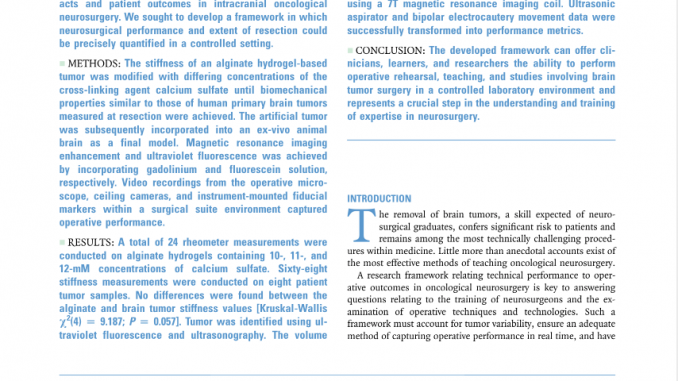
World Neurosurgery, 3 August 2020
Alexander Winkler-Schwartz, MD, Recai Yilmaz, MD, Dan Huy Tran, BSc, Houssem-Eddine Gueziri, PhD, Binbin Ying, MEng, Marius Tuznik, MSc, Vladimir Fonov, PhD, Louis Collins, PhD, David A. Rudko, PhD, Jianyu Li, PhD, Patricia Debergue, MSc, Valerie Pazos, PhD, Rolando Del Maestro, MD, PhD
https://doi.org/10.1016/j.wneu.2020.07.209
Abstract
Background The operative environment poses many challenges to studying the relationship between surgical acts and patient outcomes in intracranial oncological neurosurgery. The authors sought to develop a framework whereby neurosurgical performance and extent of resection could be precisely quantified in a controlled setting. Methods Stiffness of an alginate hydrogel-based tumor was modified with differing concentration of cross-linking agent calcium sulfate until similar biomechanical properties to human primary brain tumors measured at resection were achieved. Artificial tumor was subsequently incorporated into an ex-vivo animal brain as a final model. MRI enhancement and ultraviolet (UV) fluorescence was achieved by incorporating gadolinium and fluorescein solution, respectively. Video from operative microscope, ceiling cameras, and recordings of instrument-mounted fiducials within a surgical suite environment captured operative performance. Results Twenty-four rheometer measurements were conducted on alginate hydrogels containing 10, 11 and 12 millimolar concentrations of calcium sulfate. Sixty-eight stiffness measurements were conducted on 8 patient tumor samples. No differences were found between alginate and brain tumor stiffness values (Kruskal-Wallis χ²(4) = 9.187, p = 0.057). Tumor was identified on UV fluorescence and ultrasound. Volume and location of resected white and grey matter and residual tumor could be quantified in 0.003 mm³ increments using 7-Tesla MRI. Ultrasonic aspirator and bipolar movement data could be successfully transformed into performance metrics. Conclusion This framework can offer clinicians, learners, and researchers the ability to carry out operative rehearsal, teaching, or studies involving brain tumor surgery in a controlled laboratory environment and represents a crucial step in the understanding and training of expertise in neurosurgery.
